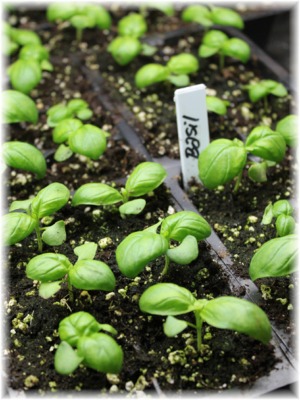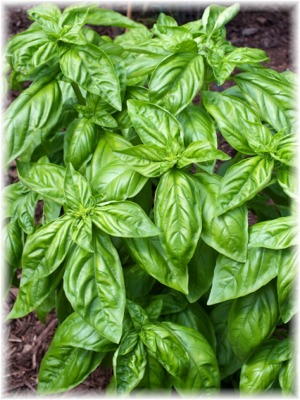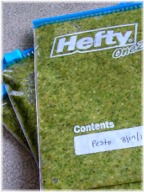Over the course of some 5,000 years, Basil has made its way around the world, earning prominence in global cuisines from Africa, through southeast Asia, to North and South America and Europe. Botanically known as Ocimum basilicum within the family Lamiaceae, its name evolved from the Greek word for king~understandably so, since it reigns as an essential culinary herb just about everywhere. Yet one country's preferred Basil likely tastes quite different from the beloved cultivar of another country. Each variety of Basil derives its own particular taste or fragrance from the specific oils it contains.

The Global Culinary Star
Most of us came to know, love and habitually crave the flavor of Basil through America's passion for sweet Basil in Italian cuisine. Its rich floral bouquet, tinged with hints of clove and licorice, is essential in pasta sauces, pizzas and pesto, and is a flavorful adornment for goat and mozzarella cheeses, Tomatoes, Garlic and silky olive oils.
Imported from Italy, Sweet Broadleaf Basil has medium-sized, deep green leaves on sturdy, 18" tall plants. Genovese Basil has slightly larger, more aromatic leaves on 24" plants and is a top pesto pick. Napolitano Mammoth-Leafed Basil has jumbo leaves that make serious pesto production a snap. They are also perfect for Basil rollups stuffed with soft herbed cheeses and ribbons of prosciutto: imagine a platter of fat green cigars. All of these sweet Basils are wonderful in fresh verdant lasagna layers, and in warm, cheese-melty paninis or imaginative open-faced sandwiches with grilled vegetables, goat cheese and savory honey. Small is beautiful too. Fino Verde Little-Leafed Basil grows into a compact little mound no more than 8" to 12" tall. Its miniature leaves have all the flavor of their full-sized cousins, and they're fun to sprinkle whole over appetizers, soups and sauces.
Yet the beauty of Basil only begins here. Growing the many different flavors and types of Basil available from seed treats us to a culinary trip around the world right in our own kitchen garden.
Originally native to Africa, Basil is an essential ingredient in recipes from Thailand to Trinidad. Most cuisines prefer the special type of Basil that compliments their region's unique flavor profile. Lemon Basil is widely used in Indonesia, where it's chopped up and served fresh with vegetables or in zesty condiments for fish and poultry. We love sprinkling Lemon Basil into tossed salads, pasta salads and potato salads for a fresh je ne sais quois embellishment. Lime Basil makes delicious marinades and sauces, especially for fish, and delightful desserts such as Lime Basil sorbet and Lime Basil shortbread cookies. Siam Queen Thai Basil has attractive dark red stems, purple flowers and slightly smaller leaves with a unique, more intense anise flavor that holds up well under the heat of cooking. Making your own drunken noodles or pho? You'll want the leaves of Thai Basil to capture that authentic scent and taste.
Mexican Spice Basil, also known as Cinnamon Basil, truly has a subtle cinnamon taste and is delicious with Pumpkin, Squash and Sweetpotato dishes. It's great in chutneys too. Try a pinch of fresh, finely minced Mexican Spice Basil sprinkled over festive skewers of cubed mango, Watermelon, peaches and Strawberries.
Marseillais Dwarf Basil hails from France and is heralded as the best-flavored Basil variety ever. Just 12" tall, it's perfect for terrace or balcony containers as well as edible garden borders.
Round Midnight Purple Basil makes a lovely addition to the garden and is a terrific edible accent plant for containers. The bushy plants produce an abundance of purple-mahogany leaves that taste good and look pretty sprinkled in tossed salads. Purple Basil vinegar turns a normal vinaigrette into something deliciously, and uniquely your own. Just steep some Purple Basil leaves in a bottle of white wine vinegar and prepare to wow your friends with a beautiful and delicious hostess gift.
Growing Basil from Seed is so Easy
Growing a bountiful supply of Basil is an easy and inexpensive luxury. It is so nice to be able to walk out your own back door and pick Basil as you need it, when its delicate, soft fresh leaves are the most perfect and delicious. It makes us feel like pampered, on-top-of-the world chefs. Its leaves, rich in volatile oils, bruise easily, which is the reason why bunches of Basil often appear so sad and defeated in the supermarket. Basil is a serious heat lover, so no matter how warm it may feel early in the Spring, do not plant it outdoors until at least a week or two after the traditional last frost date. Just talking about a light frost can be enough to kill it, and if it doesn't succumb outright, it's growth can be so stunted that it will never fully develop.
Direct sow after all danger of frost has passed, spacing seed ½" to 1" apart in well-draining soil. To start as transplants indoors, sow the seed in moist seed starting mix, about six weeks before your spring Frost-Free Date. Provide heat, bright sunlight and good ventilation. Give them 12 to 15 hours of bright light each day, very small drinks (do not over water) and good ventilation. Before transplanting your Basil seedlings into the garden, harden them off by putting them outdoors in a sheltered location for a few hours each day and bringing them in at night. Do this for a week to 10 days, gradually lengthening the time outdoors. This will help them to avoid transplant shock and to thrive. No matter how warm you think it may be, hold off transplanting until after your spring Frost-Free Date and night time temperatures are reliably above 55 degrees F.

You can find your reliable Frost-Free Date by using a chart from the National Oceanic and Atmospheric Administration (NOAA). Go HERE and select your State from the pull down menu. This will generate a PDF file with a list of NOAA data collection sites in your State. In the left column, choose the location nearest or most similar to where you live. Then read across. Use the middle threshold number (32F) and right next to it in the Spring column, will be the 50% probability date. This is your all-important average Frost-Free Date.
Some of these seedlings can go into the garden (after gradually acclimating them to the outdoors for a week or so), but be sure to plant a few of them in pots for easy access and continental ambiance. Pots of Basil thrive on balconies, terraces and decks where heat radiates and inspires its growth. Once the weather is warm and settled, Basil seeds can also be sown directly into the garden. Fertile, loamy soil and full sun are best. Cute little Basil seedlings are easy to recognize~thin them out so the mature plants will stand about 10" apart. During the growing season, the more Basil you harvest, the more your plants will produce. Pinching off flower stalks also encourages bushier, more productive plants. If you pamper Basil just a little~wait to plant it until the weather warms up, shield it from wind and scorching sun (it is a bit susceptible to sunburn)~this heavenly herb will repay you in so many delicious ways.
Preserving Basil's Goodness
We think that making pesto is the best way to preserve Basil's gorgeous color and full flavor. We make vats of our Favorite Basil Pesto and freeze it in ice cube trays as well as in flat freezer bags. Then, Pesto is an easy and delicious addition to sautéed vegetable pasta sauces, soups, chicken breast sautés, and hors d'oeuvres. Need a quick hors d'oeuvre? Press soft goat cheese in a little baking dish and top it with a thin layer of pesto (a little goes a long way). Heat it until just bubbling and serve it with crackers, crostini or pita chips. Nothing sparks up sandwiches more than pesto mixed into mayonnaise: it's great on special BLTs to which we've added crumbled goat cheese. Pesto is a wonderful surprise stuffed under the skin of a chicken before roasting. Compound Herb Butter Balls are also a good way to preserve Basil's goodness for use through the year.

Our Favorite Basil Pesto
1 1/2 cups packed Basil leaves
1/2 cup olive oil
1/3 cup freshly grated parmigiano-reggiano
1/4 cup toasted pine nuts
2 garlic cloves
You won't believe how easy it is to make pesto and how inexpensive and delicious it is compared to store bought pesto. Wash and dry the Basil leaves: a salad spinner works wonders. Put all of the ingredients in a food processor and puree until smooth. Store soon after making it, before its gleaming verdant green color looses its brilliance. You can make all different kinds of pesto by simply changing up different types of Basil, nuts and spices. For pesto with an Asian flavor, use Siam Queen Thai Basil, substitute roasted peanuts and add grated ginger root, cilantro and a bit of lemon juice.



